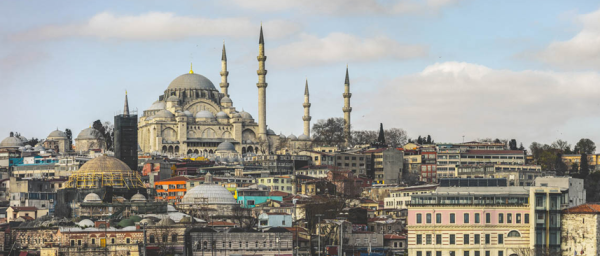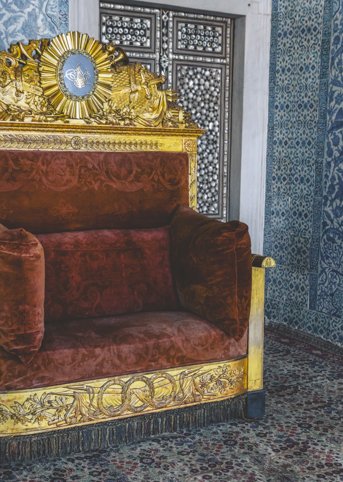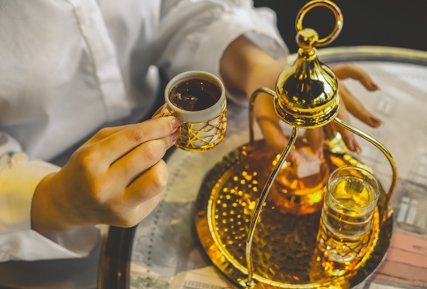17 August 2020 Beyond words
Istanbul - where east and west meet
By Tamara Gligorijević
Source: ELEVATE, Air Serbia Inflight magazine
You will certainly be impressed in Istanbul by the size of the place where civilisations constantly collided. Napoleon was convinced that this city could be the capital of the world, and that claim only makes sense when you actually find yourself there. That's because all the civilisations of the world aspired to take Istanbul, and Istanbul took the most beautiful parts from each of them and made them its own.

Long after I returned from Istanbul, resounding in my head were the words "my friend". Friends surrounded me as soon as I landed at the airport, and friendly greetings followed me wherever I went. Although the greetings came from traders, the most skilful and experienced I've ever come across, I'm not being sarcastic about their friendly greetings. That's because, for them, trading is more than merely exchanging for money, rather it is a centuries-old ritual in which I, unfortunately, have never been a worthy competitor. My clumsiness in bartering frustrated the Turkish traders to such an extent that they would, as a rule, give me some bonus when I purchased goods, angry that I wasn't more persistent in bartering. However, in my defence, if you only have three days to visit as many sights as possible, you can forget about traditional bartering and trade, because you have to hurry.
Believe it or not, this city that could hold seven Belgrades is easiest to tour on foot. That is, of course, if you’re only aiming to see the main tourist attractions, which are so conveniently close to each other that a leisurely stroll through Istanbul is the most effective option. In addition, if you are in Istanbul for the first time, you simply must visit Hagia Sophia, the Blue Mosque, Topkapi Palace and the unavoidable Grand Bazaar.
The Blue Mosque, or Sultan Ahmed Mosque, is the only mosque in the whole of Turkey to have six minarets. The decision to build them was unbelievable at the time, because until then only the Great Mosque of Mecca, the largest of all shrines, had six minarets. In order to correct this error, Sultan Ahmed financed the construction of a seventh minaret for the Great Mosque. Interestingly, one of the architects of the Blue Mosque was Mimar Hajrudin Aga, who also built the famous Old Bridge in Mostar. The Blue Mosque is today among Istanbul's most visited sites. It owes its name to its ceramic tiles from Nicaea in blue and white shades – over 20,000 of them, which still mesmerise visitors with their beauty. When you step into the mosque, regardless of the fact that you enter directly from the hustle and bustle of the city and the huge crowds that are inevitable at the entrance, you will be overwhelmed by the absolute tranquillity that reigns here. If you continue straight ahead upon leaving the mosque, your path will lead you directly to Hagia Sophia. Legend has it that Sultan Ahmed ordered the construction of the Blue Mosque in order to leave something bigger than Hagia in his name. Unlike the Blue Mosque, where you'll have to remove your shoes and don a headscarf, you can enter Hagia Sohpia casually dressed, as this former cathedral is today a museum, but you should also get ready for huge queues.





If by this juncture you haven't already felt the greatness of Istanbul, which carries within it the history of the whole world, the only city lying on two continents, you will find it in Hagia Sophia, in that wondrous fusion of Ottoman, Byzantine, Genovese, Roman and ancient Greek architecture. You will see Christian mosaics from the year 1020 and, if you look up, magnificent Islamic arabesques and fantastic medallions bearing the names of prophets written in calligraphy. Just above the medallions, you will see a restored seraphim, with a face that is an amazing sight in itself. We could say that it is magnificent, fascinating, breath-taking, but the greatness of Hagia Sophia can only be evoked by the fact that, as soon as you step inside, everything is silenced and you will feel a need to remain silent. You can declare yourself a believer or an atheist, but Hagia Sophia is awe-inspiring regardless of your religious beliefs. You will be silenced by faith and desire, whatever you think of miracles, place your thumb in the “crying pillar” or the Wishing Column, in the hope that you will extract a moist strawberry. If your thumb is wet, your wish will come true. Given that the column is made of marble and located above groundwater, you might get lucky. In the end, everything is possible in Istanbul. Another interesting element that will surely catch your attention is that there are no stairs in Hagia Sophia, rather you climb a steeply sloping stone corridor to reach the gallery. The reason for this is that the Byzantine queen insisted on being carried up to the second floor, so a wide, steep corridor was built instead of a staircase.
After that, you can carry on to Topkapi Palace and indulge in the recounting of the sultan's daily struggle to survive on the throne. The huge estate that was reserved for the most influential people in the empire, along with the harem, provides the perfect backdrop to fantasise about the sultan and his turbulent life. And from there your path leads to the Grand Bazaar…
Enchanted by aromas and colourfulness, I traversed the endlessly long labyrinths of the Bazaar, without any idea of where I was going, while saucers emerged in front of me filled with Turkish delight, baklava, various teas and coffee. I was easy prey and I was aware of it. Whatever the situation in the country is bazaars are always safe places where people don’t enter with weapons. In this place where East collides with West, one thing has always had primacy above all else, and that's trade. When it comes to trading, where you come from and what your faith is doesn't matter. It is important that you know how to trade. Although the Grand Bazaar might seem like a ruthless place to you, that's just an illusion. One of the basic rules of the bazaar is morality, and respect comes before profit. When necessary, the guards of the bazaar had the role, among others, of reminding traders of the words of the Prophet Muhammad, who himself was a merchant and who condemned unfair trade. Indeed, on the stalls and in the shops of the Grand Bazaar there is no fraud, only endless negotiations and barter.
Still turned off by barter, strolling and a pile of sampled Turkish delight and baklava, I dug my way to a small, hidden, traditional coffee shop with real Turkish coffee. Inside sat the owner, a gentleman in his later years by the name of Rafael, and I was the only customer, which gave me a chance to sample a little of everything that he had in his little coffee shop. That's how I discovered ayran, a traditional Turkish drink that I would describe as a savoury yoghurt. I drank it all, accompanied with strong, bitter coffee, while Rafael watched in wonder, expecting disaster. I returned the next day for the same combination, and the day after that. I might not have impressed the Istanbul traders, but Rafael admitted that I left him speechless. To leave a man speechless who is from this city of wonders, which is traversed by a million tourists a day and who has been watching it all unfold for decades is not negligible, don't you think? I returned from Istanbul with bags full of Turkish delight and perfumes, but also with an addiction to ayran and a load of new flavours and aromas. Those were three days filled with wonders, after which I am convinced that Napoleon knew perfectly well what he was saying when he declared Istanbul the capital of the planet.
Subscribe and don't miss out on our special offers.







